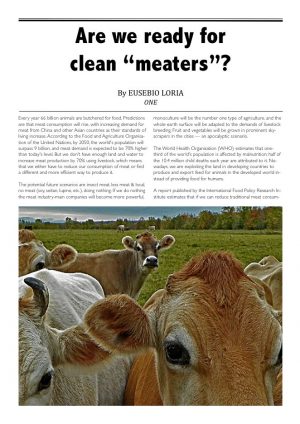 Every year 66 billion animals are butchered for food. Predictions are that meat consumption will rise, with increasing demand for meat from China and other Asian countries as their standards of living increase. According to the Food and Agriculture Organisation of the United Nations, by 2050, the world’s population will surpass 9 billion, and meat demand is expected to be 70% higher than today’s level. But we don’t have enough land and water to increase meat production by 70% using livestock, which means that we either have to reduce our consumption of meat or find a different and more efficient way to produce it.
Every year 66 billion animals are butchered for food. Predictions are that meat consumption will rise, with increasing demand for meat from China and other Asian countries as their standards of living increase. According to the Food and Agriculture Organisation of the United Nations, by 2050, the world’s population will surpass 9 billion, and meat demand is expected to be 70% higher than today’s level. But we don’t have enough land and water to increase meat production by 70% using livestock, which means that we either have to reduce our consumption of meat or find a different and more efficient way to produce it.
The potential future scenarios are insect meat, less meat & local, no meat (soy, seitan, lupine, etc.), doing nothing. If we do nothing the meat industry-main companies will become more powerful, monoculture will be the number one type of agriculture, and the whole earth surface will be adapted to the demands of livestock breeding. Fruit and vegetables will be grown in prominent skyscrapers in the cities — an apocalyptic scenario.
The World Health Organisation (WHO) estimates that one-third of the world’s population is affected by malnutrition; half of the 10.4 million child deaths each year are attributed to it. Nowadays, we are exploiting the land in developing countries to produce and export feed for animals in the developed world instead of providing food for humans.
A report published by the International Food Policy Research Institute estimates that if we can reduce traditional meat consumption in the developed world by 50 per cent, we can save 3.6 million children in the developing world from malnutrition.
United Nations’ Food and Agriculture Organization (FAO) reminds us that the livestock sector is one of the largest sources of greenhouse gases (GHG): meat industry produces 18 per cent of global greenhouse gas emissions. That is more than the emissions of all planes, trains, and cars combined.
There is no quick fix, but there is a way out. Recently research activities are addressed to find methods to make real meat in a sustainable, healthy and animal-friendly way. Lab-meat production should use up to 99% less land and 96% less water. Despite the promising numbers, the lab meat is still an open challenge. Meat cells need to be fed by 600 to 900 billion biogas factories to fix the world hunger issue in 2050.
Let’s talk about the present! Mark Post, Chief Scientific Professor at Mosameat.com, revealed the world’s first slaughter-free hamburger to a press conference in London in 2013. The burger was harvested directly from cow cells. It was the result of years of research at Maastricht University, whose cost was €250,000 – 75,000 times more expensive than an average Big Mac. It took three months to grow the meat. Since then, the race has been on to produce commercially available synthetic meat.
In 1931, Winston Churchill said: “We shall escape the absurdity of growing a whole chicken to eat the breast or wing. By growing these parts separately under a suitable medium. ”
The former British Prime Minister was ahead of his time. Today we all agree “clean meat” is more sustainable and reasonable. But how is it achievable?
The idea is that scientists could grow meat by culturing animal cells, as an alternative to harvesting flesh from an animal. The first patents were awarded to a Dutch scientist named Willem van Eelen in 1999. Shortly after that, NASA sponsored a project to grow fish muscle cells in space. Then, in the Netherlands, the Dutch government sponsored four years of academic research into what was then called “in-vitro meat.”
Some experts would argue that meat is not essential, as a vegetarian or vegan diet is healthier than a meat-based one not only for the single human being but for the whole planet. Meat products have a much larger water footprint than plants.
According to David Pimentel, a water resource specialist at Cornell University, it takes 500 litres of water to produce a kilogram of potatoes, 900 to produce a kilogram of wheat, 2000 for soybeans, and 100.000 litres of water for just one kilogram of beef.
The diet of a meat-eater requires 15 times more water than vegetable-based food diet. A meat-based diet also requires 20 times more land than a vegan one, to allow animal feed pastures and grazing.
Worldwide, we are now using 30 per cent of the earth’s land surface for livestock. “For some people, it’s easier to imagine that growing meat in a lab—not eating less meat—is the answer to those problems” That’s what has been mentioned in Cambridge at the New Harvest conference, an annual conference of scientists and entrepreneurs that constitute the emerging sector called “cellular agriculture”.
So why keep on developing meat alternatives – the so-called “fake meat”? Fake meat comes out from plant-based materials that give the taste of meat. Real “meaters” are different, as they can be grown in a laboratory. We can take all sorts of cells ranging from skin and blood to muscle (most wanted) and the brain from different animals, and grow them under controlled laboratory conditions.
The process involves three main steps. First is to select some “starter” cells from the animal and to provide them with the right environment for growth. Second is to let them grow in an environment that mimics an animal body. The third is to switch on the cells to turn into “skeletal” meat by chemical or mechanical signals.
The growing and conversion of cells into skeletal muscle are the significant challenges the industry currently faces. The appearance of this meat is likely “burger-type meat”, organised into long strands or fibres; it is not very structured. It’s feasible for some types of cells to grow fast and reproduce themselves once every 24 hours in a laboratory – this is much faster than in an animal. The challenge is to achieve this on a large scale in bio-reactors, and then to get all the cells converted from precursor cells to skeletal muscle.
The comparison between traditionally produced meat and “clean meat” says that the latter ensures 96 per cent greenhouse gas emissions reduction and requires 45 per cent less energy. The reason for this is simple: rather than wasting food energy and water on growing inedible animal body parts, all power is used to produce meat tissue. Clean meat can be virtually produced anywhere within a lab space, and it allows for city buildings to be converted into centres for meat production, thus mitigating the need for vast agricultural lands.
However, the methods used to grow meat cells in laboratories are based on regenerative technology, which, although useful, has an exorbitant cost.
The reason is that the process of harvesting the cells, placing them in a nutritional medium, and promoting them to proliferate takes an astronomical amount of money to maintain optimal conditions for only “little loot”: a trillion muscle cells only corresponds to a small amount of meat. Therefore, growing a quantity large enough for consumption requires a substantial financial investment.
Price optimisation will be necessary before growing clean meat can be a viable alternative to traditional. But things are moving anyway. “Initially, when people heard about lab-grown meat, [they] expressed scepticism about the project just because it’s something different. Now, you find people saying that they’d like to try [lab-grown meat],” said Ingrid Newkirk, president of PETA [People for the Ethical Treatment of Animals]. Artificial meat is already environmentally sustainable; the next step is to make it financially viable. Not an impossible one.
Eusebio Loria

